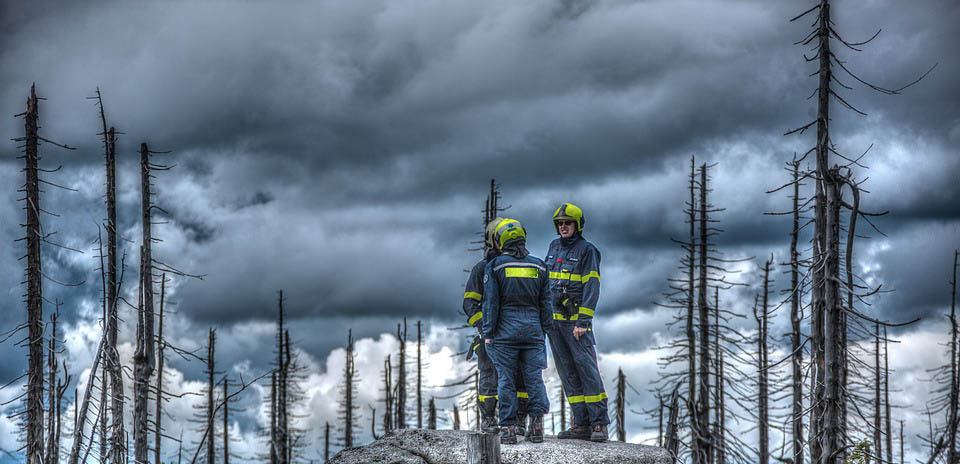Pyro-cumulonimbus plumes
Contents |
[edit] Introduction
Pyro-cumulonimbus plumes, often called pyroCb for short or more formally, cumulonimbus flammagenitus clouds (CbFg), are clouds generated by extreme heat released at the surface of the earth, such as from a volcanic eruption, or a wild fire, in some cases enhanced by localised industrial combustion emissions. They can have a distinctive grey colour because smoke particles, which can lead to thunderstorms as water condenses on their surface, and they can rise up high into the upper troposphere or lower stratosphere.
[edit] Examples
One of the earliest photographs of a major pyroCb occurred in Hiroshima, some time after the atomic bomb and its infamous atomic cloud in 1945. It was caused by the devastating ground level firestorm that jointly killed over 30% of the population of the city.
In 1991, sometime after the eruption of Mount Pinatubo in the Philippines, volcanic thunderstorms formed near its summit, but also in areas away from the summit, near smaller localised heat sources. These clouds produced rain or mud fall as it contained ashes from the initial eruption.
In 2003, 2009 and 2019 extreme summer wildfires in Australia created what were reported as fire tornadoes and significant lightening clouds throughout the period when the fires burnt. Similar incidences occurred in the US and Canada and elsewhere in 2020-2022, so much so that pyroCb's are often now referred to more commonly as fireclouds.
[edit] Comment
In 2021 a a meteorologist at the US Naval Research Laboratory noted about fireclouds that:
“You can think of them as like giant chimneys, funneling smoke that's being released by the fire up into a thunderstorm... this extremely dirty thunderstorm, with all these smoke particles for water to condense on.”.. though, the resulting water droplets don’t tend to get large enough to fall as rain. “But it is a cloud that can produce a lot of lightning,” These clouds can then advance across the landscape, sparking new wildfires as they go. So not only can the blaze propagate itself by flinging embers ahead of the main fire line, it can also produce so much hot, rising smoke that it in essence recruits the atmosphere to light more fires.
[edit] Climate change
The Fourth National Climate Assessment (NCA4), Climate Science Special Report Volume I noted that climate change enhances the drying of organic matter in forests (the material that burns and spreads wildfire), and has doubled the number of large fires between 1984 and 2015 in the western United States. The top 10 years with the largest annual acreage burned all occurred since 2004, a period which coincides with many of the warmest years on record across the US and worldwide.
Severe drought, heat and low humidity become more common and extreme as the climate warms, these hot and dry conditions are often referred to as fire weather. Scientists can measure changes in fire weather (temperature, humidity, rainfall and wind) to rate the level of danger of a wildfire striking.
The Fire Weather Index (FWI) is a meteorologically based index used worldwide to estimate fire danger. It consists of different components that account for the effects of fuel moisture and wind on fire behaviour and spread. The higher the FWI, the more favourable the meteorological conditions are for triggering a wildfire.
[edit] Related articles on Designing Buildings
- Adaptation.
- Climate.
- Climate change.
- Disaster.
- Drought.
- Exceptionally adverse weather.
- Extreme weather.
- Fire Weather.
- Flood.
- Global warming.
- Weather.
[edit] External references
Featured articles and news
Welsh Skills Body (Medr) launches ambitious plan
The new skills body brings together funding and regulation of tertiary education and research for the devolved nation.
Paul Gandy FCIOB announced as next CIOB President
Former Tilbury Douglas CEO takes helm.
UK Infrastructure: A 10 Year Strategy. In brief with reactions
With the National Infrastructure and Service Transformation Authority (NISTA).
Ebenezer Howard: inventor of the garden city. Book review.
The Grenfell Tower fire, eight years on
A time to pause and reflect as Dubai tower block fire reported just before anniversary.
Airtightness Topic Guide BSRIA TG 27/2025
Explaining the basics of airtightness, what it is, why it's important, when it's required and how it's carried out.
Construction contract awards hit lowest point of 2025
Plummeting for second consecutive month, intensifying concerns for housing and infrastructure goals.
Understanding Mental Health in the Built Environment 2025
Examining the state of mental health in construction, shedding light on levels of stress, anxiety and depression.
The benefits of engaging with insulation manufacturers
When considering ground floor constructions.
Lighting Industry endorses Blueprint for Electrification
The Lighting Industry Association fully supports the ECA Blueprint as a timely, urgent call to action.
BSRIA Sentinel Clerk of Works Training Case Study
Strengthening expertise to enhance service delivery with integrated cutting-edge industry knowledge.
Impact report from the Supply Chain Sustainability School
Free sustainability skills, training and support delivered to thousands of UK companies to help cut carbon.
The Building Safety Forum at the Installershow 2025
With speakers confirmed for 24 June as part of Building Safety Week.
The UK’s largest air pollution campaign.
Future Homes Standard, now includes solar, but what else?
Will the new standard, due to in the Autumn, go far enough in terms of performance ?
BSRIA Briefing: Cleaner Air, Better tomorrow
A look back at issues relating to inside and outside air quality, discussed during the BSRIA briefing in 2023.
Restoring Abbotsford's hothouse
Bringing the writer Walter Scott's garden to life.
Reflections on the spending review with CIAT.
























